This morning, Varnish Software and Cedexis announced their partnership and the launch of their new content delivery solution they are calling Varnish Extend. It’s an interesting offering as the solution combines Varnish Software’s high-performance caching engine with Cedexis’s scalable global traffic management software. The solution, or rather the software layer, enables companies to implement a content delivery infrastructure to be used on its own or as a part of a hybrid content delivery strategy with third-party CDN providers.
For those who are unfamiliar with Varnish Software, their caching software is one of the most popular caching solutions in the world, currently powering more than 2.5 million sites and 13% of the world’s top 10,000 sites. Their customers include large content owners, such as the New York Times, Vimeo and Twitch. Cedexis brings to the mix a powerful, cloud-based traffic management service.
The new offering gives content owners more flexibility for how they deliver their content within specific geographic regions and more control over their costs. For example, any content owner that primarily delivers content regionally, such as Sky UK or New York Daily News, can now see the benefit of delivering their content with better performance and lower cost without having to rely on a third-party CDN except to deliver content to users outside of their primary region. At least that’s what Varnish and Cedexis are promising and with both of their technologies working together at the software level, it makes for a good use-case argument. For the right set of customers, they should be able to see an immediate benefit in QoS.
 For a real-world example of how this new solution could be leveraged, Tesla would be a company where a private CDN makes perfect sense. In fact Tesla already uses Varnish Plus software for this purpose, leveraging their own network and Varnish’s software to build and operate a private CDN for their own specific content control and user experience requirements, regardless of the user’s location. Tesla may seem like an unlikely candidate for building a private CDN but the fact is that car manufacturers create a lot of proprietary content, such as videos, that they then distribute to their dealerships and customers all over the world. They want to control this proprietary content and deliver it to their end users as fast as possible just like any other media owner and there are many use cases similar to this. Having full control over how their content is delivered (over a private network vs a shared one) and the impact that has on the quality of that experience of the user is becoming business critical.
For a real-world example of how this new solution could be leveraged, Tesla would be a company where a private CDN makes perfect sense. In fact Tesla already uses Varnish Plus software for this purpose, leveraging their own network and Varnish’s software to build and operate a private CDN for their own specific content control and user experience requirements, regardless of the user’s location. Tesla may seem like an unlikely candidate for building a private CDN but the fact is that car manufacturers create a lot of proprietary content, such as videos, that they then distribute to their dealerships and customers all over the world. They want to control this proprietary content and deliver it to their end users as fast as possible just like any other media owner and there are many use cases similar to this. Having full control over how their content is delivered (over a private network vs a shared one) and the impact that has on the quality of that experience of the user is becoming business critical.
Varnish and Cedexis also said they see potential among companies that deliver content worldwide but would benefit from delivering it via their own Varnish Extend nodes closer to the origin. For example, in these conditions, a U.S. digital commerce company will benefit from directing their Singaporean traffic to a Varnish node in Singapore rather than to the origin, especially if Singapore is one of their largest markets. In the same manner companies with a lot of cold/long-tail content, such as video on demand libraries, could use Varnish Extend to set up one or more Varnish nodes behind their CDNs, in front of the origin, to optimize content delivery and cache-hit ratio, protecting the origin from sudden floods of calls from the third-party CDN.
Cedexis and Varnish Software told me they shared one clear objective in establishing their partnership: to deliver something new to a market of content providers always looking for ways to better serve their end users; something beyond a DIY solution. Realizing that convenience is key in a market where setup and management overhead is really the only remaining reason for customers to outsource their delivery to a single, third-party CDN provider. Thus, the objective expanded to not only launching a new content delivery solution but also offer the convenience of getting up and running within a matter of hours. It’s from this idea that Varnish Extend was born.
In addition to the new ingredients Varnish Extend brings to the content delivery market the product needs to (and can) check all the web performance optimization boxes including:
- Availability: The product offers resiliency across multiple platforms allowing customers to avoid single point of failure with one single CDN/DC.
- Cost: Transparent and easy-to-understand subscription-based pricing model. Based on number of nodes and requests (millions of requests), not capacity (bandwidth). Addresses the growing decoupling between the content owners cost and service monetization. A business model that lets content owners cost efficiently scale to support a richer media experience (HD/4K&VR/360)
- Control & Flexibility: Customers will have the ability to add or remove Varnish Extend nodes as needed using an operation-friendly automated interface/API.
- Pure Performance: No longer relying on a single CDN strategy allows Varnish Extend customers to improve the delivery of any type of content (HLS, VOD, images, etc) to users in areas where their CDN’s delivery is not optimal.
With its pre-integrated stack and blueprint documentation, customers get a content delivery infrastructure that can be up and running in as little as four hours. Additionally, the control and flexibility the Varnish Configuration Language (VCL) brings to this product is unique. VCL is a small domain-specific language designed to be used to define request handling and document caching policies. This gives customers of Varnish Extend perfect control over what type of content (VOD, HLS, images, etc.) they deliver: how, to whom and from where. Varnish Extend is available from Varnish-Software.com on a subscription-based pricing model starting at $2,500 a month and is the first of what I am expecting will be multiple private and managed CDN service offerings coming to the market over the next few months.



